| Listing 1 - 10 of 16 | << page >> |
Sort by
|
Book
ISSN: 02435624 ISBN: 2852063344 9782852063341 Year: 1986 Publisher: Paris: Lavoisier,
Abstract | Keywords | Export | Availability | Bookmark
 Loading...
Loading...Choose an application
- Reference Manager
- EndNote
- RefWorks (Direct export to RefWorks)
Food --- Toxicology --- Composition --- Food - Toxicology --- Food - Composition
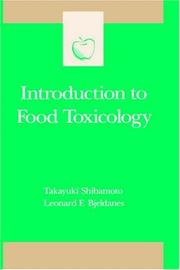
ISBN: 0126400253 0080925774 1299192807 Year: 1993 Publisher: San Diego : Academic Press, Inc.,
Abstract | Keywords | Export | Availability | Bookmark
 Loading...
Loading...Choose an application
- Reference Manager
- EndNote
- RefWorks (Direct export to RefWorks)
The area of food toxicology currently has a high profile of interest in the food industry, universities, and government agencies, and is certainly of great concern to consumers. There are many books which cover selected toxins in foods (such as plant toxins, mycotoxins, pesticides, or heavy metals), but this book represents the first pedagogic treatment of the entire range of toxic compounds found naturally in foods or introduced by industrial contamination or food processing methods. Featuring coverage of areas of vital concern to consumers, such as toxicological implications of food adultera
Food --- Aliments --- Toxicology --- Toxicologie --- Agrotechnology and Food Sciences. Toxicology --- Toxicology. --- Food Toxicology --- Food Toxicology.
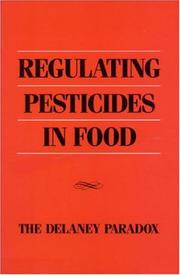
ISBN: 0309037468 9786610221585 1280221585 0309555078 0585150001 9780585150000 9780309037464 Year: 1987 Publisher: Washington, D.C. National Academy Press
Abstract | Keywords | Export | Availability | Bookmark
 Loading...
Loading...Choose an application
- Reference Manager
- EndNote
- RefWorks (Direct export to RefWorks)
Concern about health effects from exposure to pesticides in foods is growing as scientists learn more about the toxic properties of pesticides. The Delaney Clause, a provision of the Food, Drug and Cosmetic Act, prohibits tolerances for any pesticide that causes cancer in test animals or in humans if the pesticide concentrates in processed food or feeds. This volume examines the impacts of the Delaney Clause on agricultural innovation and on the public's dietary exposure to potentially carcinogenic pesticide residues. Four regulatory scenarios are described to illustrate the effects of varying approaches to managing oncogenic pesticide residues in food.
Food additives --- Pesticide residues in food --- Agrotechnology and Food Sciences. Toxicology --- Law and legislation --- Food Toxicology --- Food Toxicology. --- Pesticides --- Pesticide residues in food. --- Government policy --- Toxicology. --- Pesticide residues --- Food contamination --- Environmental aspects
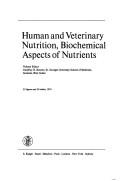
ISBN: 3805526970 9783805526975 Year: 1978 Volume: vol. 29 Publisher: Basel: Karger,
Abstract | Keywords | Export | Availability | Bookmark
 Loading...
Loading...Choose an application
- Reference Manager
- EndNote
- RefWorks (Direct export to RefWorks)
Toxicology --- Nutrition --- Metabolism --- Food poisoning --- Toxicologie --- Congresses --- Congrès --- Food --- Congrès --- Toxicology - Congresses --- Nutrition - Congresses --- Metabolism - Congresses --- Food - Toxicology - Congresses
Periodical
ISSN: 26438429 Year: 2020 Publisher: [Beijing, China] John Wiley & Sons, Inc.
Abstract | Keywords | Export | Availability | Bookmark
 Loading...
Loading...Choose an application
- Reference Manager
- EndNote
- RefWorks (Direct export to RefWorks)
Food science --- Food --- Research --- Food science. --- Research. --- Science --- Foods --- Dinners and dining --- Home economics --- Table --- Cooking --- Diet --- Dietaries --- Gastronomy --- Nutrition --- food chemistry --- food toxicology --- food technology --- food packaging --- nutrition --- global food chain sustainability --- Food technology --- Chemical engineering --- Primitive societies
Periodical
ISSN: 26663066 Year: 2020 Publisher: Amsterdam : Tamil Nadu, India : [Milton, Australia] : Atlantis Press Visaaga Publishing House John Wiley & Sons Australia, Ltd.
Abstract | Keywords | Export | Availability | Bookmark
 Loading...
Loading...Choose an application
- Reference Manager
- EndNote
- RefWorks (Direct export to RefWorks)
food chemistry --- food satety --- nutrition --- food science --- food microbiology --- food toxicology --- Food --- Nutrition --- Aliments --- Food. --- Nutrition. --- Alimentation --- Health --- Physiology --- Diet --- Dietetics --- Digestion --- Food habits --- Malnutrition --- Foods --- Dinners and dining --- Home economics --- Table --- Cooking --- Dietaries --- Gastronomy --- Health aspects --- Primitive societies
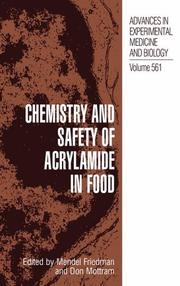
ISBN: 1280623845 9786610623846 038724980X 0387239200 1441936726 Year: 2005 Publisher: New York : Springer,
Abstract | Keywords | Export | Availability | Bookmark
 Loading...
Loading...Choose an application
- Reference Manager
- EndNote
- RefWorks (Direct export to RefWorks)
Reports that heat processing of foods induces the formation of acrylamide heightened interest in the chemistry, biochemistry, and safety of this compound. Acrylamide-induced neurotoxicity, reproductive toxicity, genotoxicity, and carcinogenicity are potential human health risks based on animal studies. Because exposure of humans to acrylamide can come from both external sources and the diet, there exists a need to develop a better understanding of its formation and distribution in food and its role in human health. To contribute to this effort, experts from eight countries have presented data on the chemistry, analysis, metabolism, pharmacology, and toxicology of acrylamide. Specifically covered are the following aspects: exposure from the environment and the diet; biomarkers of exposure; risk assessment; epidemiology; mechanism of formation in food; biological alkylation of amino acids, peptides, proteins, and DNA by acrylamide and its epoxide metabolite glycidamide; neurotoxicity, reproductive toxicity, and carcinogenicity; protection against adverse effects; and possible approaches to reducing levels in food. Cross-fertilization of ideas among several disciplines in which an interest in acrylamide has developed, including food science, pharmacology, toxicology, and medicine, will provide a better understanding of the chemistry and biology of acrylamide in food, and can lead to the development of food processes to decrease the acrylamide content of the diet.
Acrylamide --- Food --- Toxicology. --- Food toxicology --- Nutritional toxicology --- Toxicology --- Nutritionally induced diseases --- Acrylic amide --- Propenamide --- Propenoic acid amide --- Acrylates --- Amides --- Food science. --- Chemistry. --- Food Science. --- Chemistry/Food Science, general. --- Physical sciences --- Science --- Food technology --- Chemical engineering --- Food Technology. --- Food Sciences --- Technology, Food --- Food Science --- Science, Food --- Sciences, Food --- Nutritional Sciences
Periodical
ISSN: 18489923 18473466 Year: 2009 Publisher: Osijek : Faculty of Food Technology Osijek, University of Josip Juraj Strossmayer in Osijek,
Abstract | Keywords | Export | Availability | Bookmark
 Loading...
Loading...Choose an application
- Reference Manager
- EndNote
- RefWorks (Direct export to RefWorks)
Food --- Food industry and trade --- Research --- Research. --- Food preparation industry --- Food processing industry --- Food trade --- Foods --- nutrition --- food quality --- processning of agricultural products --- food chemistry --- microbiology --- food toxicology --- Agricultural processing industries --- Processed foods --- Dinners and dining --- Home economics --- Table --- Cooking --- Diet --- Dietaries --- Gastronomy --- Nutrition --- Food processing --- Food technology --- Processing --- Food science and technology --- Primitive societies
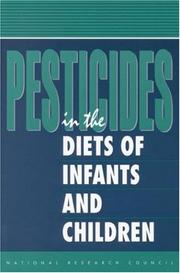
ISBN: 0309048753 9786610196609 1280196602 030958535X 0585030669 9780585030661 6610196605 9780309048750 Year: 1993 Publisher: Washington, D.C. National Academy Press
Abstract | Keywords | Export | Availability | Bookmark
 Loading...
Loading...Choose an application
- Reference Manager
- EndNote
- RefWorks (Direct export to RefWorks)
Food Contamination --- Pesticides --- Diet --- Environmental Exposure --- Pesticide Residues --- Food contamination --- Infant formulas --- Pediatric toxicology --- Pesticide residues in food --- Aliments --- adverse effects --- in infancy & childhood --- toxicity --- Contamination --- Toxicology --- Toxicologie --- MEDICAL --- Investigative Techniques --- Body Burden --- Toxic Actions --- Environmental Pollution --- Age Groups --- Nutritional Physiological Phenomena --- Specialty Uses of Chemicals --- Food Safety --- Agrochemicals --- Public Health --- Chemical Actions and Uses --- Physiological Phenomena --- Analytical, Diagnostic and Therapeutic Techniques and Equipment --- Persons --- Environment and Public Health --- Named Groups --- Chemicals and Drugs --- Phenomena and Processes --- Health Care --- Infant --- Child --- Health & Biological Sciences --- Toxicology & Public Health --- Pediatric toxicology. --- Food contamination. --- Pesticides. --- Food Contamination. --- Agrotechnology and Food Sciences. Toxicology --- Agrotechnology and Food Sciences. Food Sciences --- Toxicology. --- Contamination. --- in infancy & childhood. --- Food Toxicology --- Food Quality and Safety --- Food Toxicology. --- Food Quality and Safety. --- Contaminated food --- Food --- Foods, Contaminated --- Poisoning in children --- Pesticide Residues. --- Contamination (Technology) --- Food adulteration and inspection --- Children --- Diseases --- adverse effects. --- toxicity.
Book
ISBN: 144197685X 9786613081704 1441976868 1283081709 Year: 2011 Publisher: New York, N.Y. : Springer,
Abstract | Keywords | Export | Availability | Bookmark
 Loading...
Loading...Choose an application
- Reference Manager
- EndNote
- RefWorks (Direct export to RefWorks)
Foodborne illnesses caused by various bacterial, viral, and fungal pathogens lead to a high number of morbidity and mortality in the U.S. and throughout the world. Recent advances in microbial genomics have significantly improved our understanding of the physiology, evolution, ecology, epidemiology, and pathogenesis of different foodborne pathogens. This book focuses on the genomics of foodborne bacterial pathogens. It begins with a brief overview of the recent advances in microbial genomics and the impact of genomics on food safety research. Then, eight chapters follow that elaborate some in-depth reviews on the genomics of several common foodborne bacterial pathogens including Bacillus, Campylobacter, Clostridium, Escherichia coli, Listeria, Salmonella, Staphylococcus, and Vibrio. Finally, the last four chapters focus on some current genomic, transcriptomic, and proteomic technologies and their applications in studying the epidemiology, evolution, and pathogenesis of foodborne bacterial pathogens. Genomics of Foodborne Bacterial Pathogens can be used as a reference by scientists and professionals in academia, government, and industry who are interested in understanding microbial genomics and using genomics tools to study foodborne bacterial pathogens. This book can also be used as a textbook for instructors and professors who teach food microbiology or microbial genomics-related courses at the post-graduate level.
Bacterial diseases. --- Food --Toxicology. --- Foodborne diseases --Microbiology. --- Pathogenic bacteria. --- Foodborne diseases --- Pathogenic bacteria --- Food --- Bacterial diseases --- Biology --- Poisoning --- Computational Biology --- Investigative Techniques --- Genome --- Organisms --- Biological Science Disciplines --- Genetic Structures --- Analytical, Diagnostic and Therapeutic Techniques and Equipment --- Substance-Related Disorders --- Genetic Phenomena --- Natural Science Disciplines --- Diseases --- Disciplines and Occupations --- Phenomena and Processes --- Bacteria --- Genomics --- Foodborne Diseases --- Genome, Bacterial --- Microbiology --- Methods --- Genetics --- Public Health --- Health & Biological Sciences --- Biomedical Engineering --- Microbiology & Immunology --- Toxicology --- Microbiology. --- Toxicology. --- Bacterial infections --- Food toxicology --- Nutritional toxicology --- Bacteria, Pathogenic --- Disease germs --- Food-borne diseases --- Foodborne illnesses --- Life sciences. --- Bacteriology. --- Microbial genetics. --- Microbial genomics. --- Life Sciences. --- Microbial Genetics and Genomics. --- Food Science. --- Biotechnology. --- Communicable diseases --- Medical bacteriology --- Nutritionally induced diseases --- Pathogenic microorganisms --- Food science. --- Science --- Microbial genetics --- Microorganisms --- Food—Biotechnology.
| Listing 1 - 10 of 16 | << page >> |
Sort by
|

 Search
Search Feedback
Feedback About UniCat
About UniCat  Help
Help News
News